Centrad 752 - The French "AVO"!
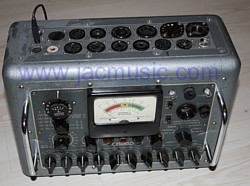 This was an exceptional find. I will describe it later. I noticed it's from the city of Annecy, same as were the Metrix U61B comes from. That relation is perhaps no coincidence. This tester looks a bit like a Taylor 45C. It has one defective selector switch, but that looks easy to repair. Just need to have time. So I cannot select every tube, but almost any. This little pearl is based on the circuitry of the 45C, but it has more and better options, also it had the selectors for any random tube, same as the AVO's have. All together this is a mix of AVO Mk1, Taylor 45C, and the designer saved absolutely not on nice options. It has for instance the professional leakage test method, same as the AVO's have. This means a real ohms measurement, but with a high voltage as bias. These French designers were aware, sometimes the one, sometimes the other method is better. Heater voltage very interestingly done, with a coarse and a fine adjustment. Well, I have not really looked at it in full detail, but I will probably restore it completely. Some incandescent lamps are used as a fuse, same as Hickok does. Fact is, the tester works, and is precise. It can do many of the European B4B5 socket tubes like PX4, PX 25, etc. Easy to handle and a nice design. This was an exceptional find. I will describe it later. I noticed it's from the city of Annecy, same as were the Metrix U61B comes from. That relation is perhaps no coincidence. This tester looks a bit like a Taylor 45C. It has one defective selector switch, but that looks easy to repair. Just need to have time. So I cannot select every tube, but almost any. This little pearl is based on the circuitry of the 45C, but it has more and better options, also it had the selectors for any random tube, same as the AVO's have. All together this is a mix of AVO Mk1, Taylor 45C, and the designer saved absolutely not on nice options. It has for instance the professional leakage test method, same as the AVO's have. This means a real ohms measurement, but with a high voltage as bias. These French designers were aware, sometimes the one, sometimes the other method is better. Heater voltage very interestingly done, with a coarse and a fine adjustment. Well, I have not really looked at it in full detail, but I will probably restore it completely. Some incandescent lamps are used as a fuse, same as Hickok does. Fact is, the tester works, and is precise. It can do many of the European B4B5 socket tubes like PX4, PX 25, etc. Easy to handle and a nice design.
There is the original French manual, and a very well made translation in Dutch. This Dutch translation you can enter in the Google translator and it nicely gives English instructions.
As a pre-test it has a way to test the cathode all alone, so without any function of the rest of the tube. They write in French, this indicates a troublesome tube, but for the rest the transconductance should be tested to judge the tube.
VOLTAGES: Grid voltage can be set from 0...15V. Anode and Screen voltage are selectable from 6...250V, in well choose steps and combinations. Heater voltage can be set for almost every possible voltage. This method is very clever, and results in a relatively simple switch. Moreover, you can varied all voltages up and down 1V or 2V, which is really very handy to test emission quality.
TRANSFORMERS: It has a separate heater and anode transformer. Many better tube testers have this.
Many things of this tester makes me realize they some very talented people tried to do a good job, and they succeeded also. This this tester gives you: A pre-test, a transconductance test, and a "Quality Test". Whereas the CONAR (below here) only presents a COLOR. Yes, you get only a color, so it's red, yellow, or green, and that's all this silly CONAR will tell you. What a difference with the CENTRAD!
VALUE: There are very little of those around, so there is little reference. But you have to make good note, it has an excellent variety of useful tube sockets, both USA and European, it has all the heater voltages, and 1:1 setting of the socket connections, just by the tube data sheet, to test for any new tube that would be invented later. The panel meter itself is robust and of excellent quality. Operation and many details remind me of the Taylor 45B, and price should be in that range. Given that people pay 250 Euro for such a silly and useless CONAR as pictured below, the Centrad 752 is worth 3x as much. So we talk about 600...800 Euro, similar like a 45B. Though the Centrad can do more than the 45B.
Size and weight: It is larger as it looks on the picture, and actually quite heavy, the metal handles make sense.
ManualFrench - ManualDutch - MeterPicture
CONAR
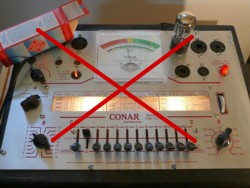 Infamous brand tube checker. The CONAR brand should not be confused with CANOR, which is a high quality digital tube tester. The CONAR uses all tubes as a rectifier, and load that rectifier circuit with a variable resistor. It's the 'D' knob here. This tester works at too low voltage. The good function of a tube tester is not to show that new tubes are 'good', and broken tubes are 'bad'. The question is, when the tester says the tube is somewhere in between, how the magic works. It works at very low level and makes many mistakes. So when the tube is in the green it may be good indeed. Or may be bad as well. I would say it is worth 50$ for the fun of owning it, but you cannot test tubes with it in a reliable way. No stop! I am wrong about the 50$. It's worth a lot more, because you can sell it on Ebay easily for 200$, and when you picture it with an EL34 far in the green, you get even 250$ for it. Or perhaps you have even an original Telefunken in it's box. Picture it with that tube on it, and you get even 300$. Yes, that's what you should do with it. Infamous brand tube checker. The CONAR brand should not be confused with CANOR, which is a high quality digital tube tester. The CONAR uses all tubes as a rectifier, and load that rectifier circuit with a variable resistor. It's the 'D' knob here. This tester works at too low voltage. The good function of a tube tester is not to show that new tubes are 'good', and broken tubes are 'bad'. The question is, when the tester says the tube is somewhere in between, how the magic works. It works at very low level and makes many mistakes. So when the tube is in the green it may be good indeed. Or may be bad as well. I would say it is worth 50$ for the fun of owning it, but you cannot test tubes with it in a reliable way. No stop! I am wrong about the 50$. It's worth a lot more, because you can sell it on Ebay easily for 200$, and when you picture it with an EL34 far in the green, you get even 250$ for it. Or perhaps you have even an original Telefunken in it's box. Picture it with that tube on it, and you get even 300$. Yes, that's what you should do with it.
 This tester wins the . This tester wins the .
Picture series here
DIY TESTER (1)
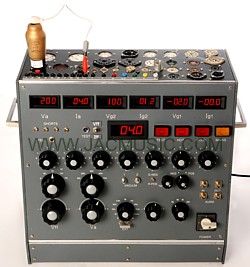 Many DIY testers exist, and it is interesting to see sometimes 50 years old versions of those. Some are really nice done, and some not so nice. Today, often the testers are made as digital products, and you can see the maker getting deeply into software issues, and the hardware getting larger as intended. For that reason, a nice way is use digital panel meters, and for the rest set up the tester in the good old analog way. From my own experience I can say, use only industrial meters for this. The Chinese Ebay meters have unlinearity problems. Suppose you calibrate it for 1000V full scale , and measure 99V. So you switch to the 100V range to get more accuracy, but you measure suddenly 98V. (Mmmm ?!) The reason is panel meter internal unlinearity. You can't calibrate that away. The expensive meters don't have this problem. Since the tester is an instrument, you need to make the full concept before you start, keep the wiring simple, yet prevent to forget functions that you have to add later. So the thing gets serviceable later. With the concept being 'final' from the beginning, you can make a nice front plate, use nice knobs, and paint it professional. Here is one of those products, which I think is extremely well done. It was made by a private person. He is 78 years old, (while I write this in 2011). He admires tubes for the industrial design 'art' in them. So this is somebody with time and experience, and the right heart beat to build something ultimate. The result is the most beautiful analog tester I ever saw. Read more about it. Many DIY testers exist, and it is interesting to see sometimes 50 years old versions of those. Some are really nice done, and some not so nice. Today, often the testers are made as digital products, and you can see the maker getting deeply into software issues, and the hardware getting larger as intended. For that reason, a nice way is use digital panel meters, and for the rest set up the tester in the good old analog way. From my own experience I can say, use only industrial meters for this. The Chinese Ebay meters have unlinearity problems. Suppose you calibrate it for 1000V full scale , and measure 99V. So you switch to the 100V range to get more accuracy, but you measure suddenly 98V. (Mmmm ?!) The reason is panel meter internal unlinearity. You can't calibrate that away. The expensive meters don't have this problem. Since the tester is an instrument, you need to make the full concept before you start, keep the wiring simple, yet prevent to forget functions that you have to add later. So the thing gets serviceable later. With the concept being 'final' from the beginning, you can make a nice front plate, use nice knobs, and paint it professional. Here is one of those products, which I think is extremely well done. It was made by a private person. He is 78 years old, (while I write this in 2011). He admires tubes for the industrial design 'art' in them. So this is somebody with time and experience, and the right heart beat to build something ultimate. The result is the most beautiful analog tester I ever saw. Read more about it.
FIVE STARS *****
DIY TESTER (2)
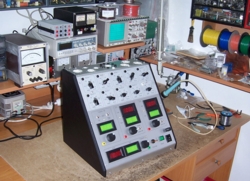 A picture of his DIY tester tester was send to me by a French DIY enthusiast. I have no more information than the picture, but click on it for a enlargement. You can see many interesting details A picture of his DIY tester tester was send to me by a French DIY enthusiast. I have no more information than the picture, but click on it for a enlargement. You can see many interesting details
FIVE STARS *****
DIY TESTER (3)
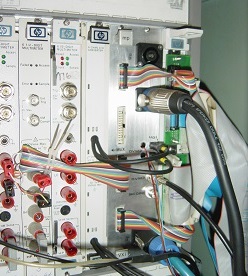
This tester was build by a German person, who knows a lot a about software and test equipment, and we on the phone about this a few times. On Ebay you can buy used VXI boards. When 5 1/2 digits is enough for you these boards are cheap! I see them go for 50$ often. This is an older standard, but that does not mean these are not great tools. These are plug in versions of regular, and well known Hewlett Packard instruments, such as their multi meters which everybody uses. Such multi meters were a standard for their time, and they are still good and values to day by collectors and users. The VXI versions of those have no display and no knobs or buttons. The control is done only via PC, and reading the measurement data also. Because many do not know how to use this, these VXI boards can sometimes be found cheap, and yet represent a beautiful Hewlett Packard multimeter. Moreover, the boards take little space. So many fit into a rack. This is a so called VXI rack. This standard was also adopted by some other vendors like Siemens and Tektronix. The boards get their power supply from the VXI rack, and the computer interface is also with the VXI rack itself. So you can just stick 5 multi meters in, and then access the VIX rack via your computer. So the hardware is all there, and it is really fantastic hardware, and sold at Ebay for give away prices.
So what is the drawback? It is the software and the interface. With the hardware you are done before you know it. All you need to do is plug in the boards, and you have many analog inputs and outputs. Just how to control and read them? For this, there is a data bus, called IEEE, which has is a parallel connector which plugs into a PC card, with a IEEE cable. Those cables go cheap on Ebay. The PC cards are expensive, there is just little supply and high demand. They go from 150...300 Euro on Ebay. So that's the main investment.
Next ist, you need software. I use "Agilent VEE" for instrument control, but there is also freeware around. If you really want to play with VXI, I would recommend you to stay with one vendor, to prevent getting stuck in compatibility problems. Since this here is about Hewlett Packard VIX cards, you should use VEE. This software can read from, and write to the modules. This is object oriented software. So a Voltmeter is displayed as a block in the software, already showing it's voltage in real time. Then, you can connect it with software "cables" to other modules, which appear on your screen as well. So you set up the whole measurement system in software, which makes it look like an electronic circuit. And this is indeed what it is, only the connections are in software. The software offers all timers, start/stop buttons, and all the usual if-then-else commands programmers need.
If you can get hold of a free copy of the program called "Agilent VEE", that may be really nice to use with those older HP or Agilent VXI cards. With such a program you can write to the multi meters, like set the range, Volt, mA, or Ohms, etc. And then read the result from it. On card can measure current and voltage of a device at the same time, because the banana plugs for that are another. Just as with a normal multimeter, you can also hook it up to a circuit and measure current and voltage at the same time, you just need to push some of the button "Volts" and "DC", and read volts. Then push "mA", "DC" and read the current. This pushing of the buttons is done in software. So for a tube tester you need probably 4 such cards. You need also programmable power supplies, which this person build himself. For your won DIY tube tester that will be the harder issue. You have to consider this something similar to the Roetest, which works not with VXI, but basically the same way. For normal people the Roetest is probably better. Some pictures here: Pic1 - Pic2 - Pic3 - Pic4 - Pic5 - VXI-PDF-Info
ELPO P508 TUBE TESTER
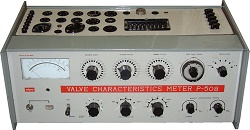 ELPO is a Polish company who made top class products. Many of those were state of the art at it's time, and even today many are remarkable. There is definitely some story behind those testers, of which I can see some of the results, but I do not know the details. If someone knows more, please let me know, I will be glad to place it here. For sure is, at AVO, the story ended with their Mk4, and the different looking VCM163. For the P508 (pictured here), ELPO has used the basic design of the AVK Mk4, and improved it, into a more modern machine. Improvements are several, such as do away with those silly gear wheels of the Mk4, for grid voltage and Gm, which only purpose was to suggested fake precision. Doing this like in the older Mk3, made the P508 more compact, and to my opinion better. They have used a smaller size, but MUCH stronger meter, with mirror scale, and perhaps it is a tout bank meter. I need to look inside for that, but I expect so. The sockets are those exceptional good sockets of the Russian L3-3, I don't know how they managed to get those, but they did. The roller wheel is obviously purchased from AVO, and for all electrode connections they have those banana plugs system same as NEUBERGER. So wow....somebody has been thinking very much, about how to add the best of several good products into this one The case is idiot proof, so it can be send with the post office. Read more about it. ELPO is a Polish company who made top class products. Many of those were state of the art at it's time, and even today many are remarkable. There is definitely some story behind those testers, of which I can see some of the results, but I do not know the details. If someone knows more, please let me know, I will be glad to place it here. For sure is, at AVO, the story ended with their Mk4, and the different looking VCM163. For the P508 (pictured here), ELPO has used the basic design of the AVK Mk4, and improved it, into a more modern machine. Improvements are several, such as do away with those silly gear wheels of the Mk4, for grid voltage and Gm, which only purpose was to suggested fake precision. Doing this like in the older Mk3, made the P508 more compact, and to my opinion better. They have used a smaller size, but MUCH stronger meter, with mirror scale, and perhaps it is a tout bank meter. I need to look inside for that, but I expect so. The sockets are those exceptional good sockets of the Russian L3-3, I don't know how they managed to get those, but they did. The roller wheel is obviously purchased from AVO, and for all electrode connections they have those banana plugs system same as NEUBERGER. So wow....somebody has been thinking very much, about how to add the best of several good products into this one The case is idiot proof, so it can be send with the post office. Read more about it.
HICKOK TUBE TESTERS
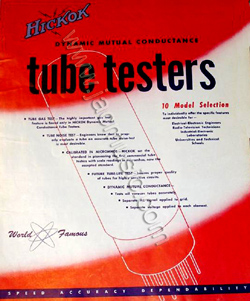 Hickok Tester, how to choose the right model Hickok Tester, how to choose the right model
They made a variety of tube testers, each for the right purpose. You will read this more often on the pages here, but you need to take the tube tester which fits your needs. Do you run a laboratory, find yourself a lab tester. They work a lot more complicated, so more buttons to set, and testing takes longer. Are you a service man, just want to know if the tube must be replaced, look for the smaller versions.
- Models before the Hickok patent. Very old testers, not practical today
- Technician models, Large case
Gives a quick result, easy to operate. Has some special features like life-time test. Medium precision. Large case, with lots of space inside to add extra sockets, or 115V to 230V transformer
- Technician models, Small case
- Simplified versions of the large case testers. Lower precision, smaller size.
- Laboratory models. Require more settings, but can also do more. Have higher generic precision, due to less compromises with the circuitry. Some have even a separate filament transformer.
- Card matic
Go to Hickok Main Page
TEKTRONIX TUBE TESTERS
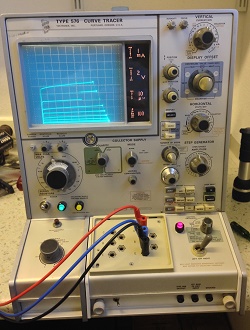 This company build several excellent curve tracers. Earliest model is the 575, a real tube curve tracer. It is probably the most sought after device of it's kind. But that is only because very few were ever made, most of them are in terrible condition, and we have today a huge crowd of tube doctors who all seem to think this is "the" item they MUST have. There is a far better device to my opinion, which is the 576, transistor tester. With some small modifications, which are not difficult to do, can test tubes just as well, but then... SO MUCH BETTER. Most 576 still have a trace on the screen, and need only service and repair. Documentation is very good, and spare parts, or units for parts, can be found easily. I think the 576 is the best curve tracer of it's kind, ever build. It surprises with it's no-compromise features, and exceptional measurement range. It can display curves of detector diodes in the uA and mV range, but as well tests devices up to 20A, 400W, 1500V. There is almost no limit to what it can do. It can even do 4-Wire testing. Since it's made for FET Testing as well, you can test triodes on it, but you do need to supply the heater voltage with an external power supply. You can easily test for instance an 845 triode on it, at 1500V, 100 Watt, fully analog, heating up the anode. Read more about it. This company build several excellent curve tracers. Earliest model is the 575, a real tube curve tracer. It is probably the most sought after device of it's kind. But that is only because very few were ever made, most of them are in terrible condition, and we have today a huge crowd of tube doctors who all seem to think this is "the" item they MUST have. There is a far better device to my opinion, which is the 576, transistor tester. With some small modifications, which are not difficult to do, can test tubes just as well, but then... SO MUCH BETTER. Most 576 still have a trace on the screen, and need only service and repair. Documentation is very good, and spare parts, or units for parts, can be found easily. I think the 576 is the best curve tracer of it's kind, ever build. It surprises with it's no-compromise features, and exceptional measurement range. It can display curves of detector diodes in the uA and mV range, but as well tests devices up to 20A, 400W, 1500V. There is almost no limit to what it can do. It can even do 4-Wire testing. Since it's made for FET Testing as well, you can test triodes on it, but you do need to supply the heater voltage with an external power supply. You can easily test for instance an 845 triode on it, at 1500V, 100 Watt, fully analog, heating up the anode. Read more about it.
|

 Infamous brand tube checker. The CONAR brand should not be confused with CANOR, which is a high quality digital tube tester. The CONAR uses all tubes as a rectifier, and load that rectifier circuit with a variable resistor. It's the 'D' knob here. This tester works at too low voltage. The good function of a tube tester is not to show that new tubes are 'good', and broken tubes are 'bad'. The question is, when the tester says the tube is somewhere in between, how the magic works. It works at very low level and makes many mistakes. So when the tube is in the green it may be good indeed. Or may be bad as well. I would say it is worth 50$ for the fun of owning it, but you cannot test tubes with it in a reliable way. No stop! I am wrong about the 50$. It's worth a lot more, because you can sell it on Ebay easily for 200$, and when you picture it with an EL34 far in the green, you get even 250$ for it. Or perhaps you have even an original Telefunken in it's box. Picture it with that tube on it, and you get even 300$. Yes, that's what you should do with it.
Infamous brand tube checker. The CONAR brand should not be confused with CANOR, which is a high quality digital tube tester. The CONAR uses all tubes as a rectifier, and load that rectifier circuit with a variable resistor. It's the 'D' knob here. This tester works at too low voltage. The good function of a tube tester is not to show that new tubes are 'good', and broken tubes are 'bad'. The question is, when the tester says the tube is somewhere in between, how the magic works. It works at very low level and makes many mistakes. So when the tube is in the green it may be good indeed. Or may be bad as well. I would say it is worth 50$ for the fun of owning it, but you cannot test tubes with it in a reliable way. No stop! I am wrong about the 50$. It's worth a lot more, because you can sell it on Ebay easily for 200$, and when you picture it with an EL34 far in the green, you get even 250$ for it. Or perhaps you have even an original Telefunken in it's box. Picture it with that tube on it, and you get even 300$. Yes, that's what you should do with it.  This tester wins the
This tester wins the  Many DIY testers exist, and it is interesting to see sometimes 50 years old versions of those. Some are really nice done, and some not so nice. Today, often the testers are made as digital products, and you can see the maker getting deeply into software issues, and the hardware getting larger as intended. For that reason, a nice way is use digital panel meters, and for the rest set up the tester in the good old analog way. From my own experience I can say, use only industrial meters for this. The Chinese Ebay meters have unlinearity problems. Suppose you calibrate it for 1000V full scale , and measure 99V. So you switch to the 100V range to get more accuracy, but you measure suddenly 98V. (Mmmm ?!) The reason is panel meter internal unlinearity. You can't calibrate that away. The expensive meters don't have this problem. Since the tester is an instrument, you need to make the full concept before you start, keep the wiring simple, yet prevent to forget functions that you have to add later. So the thing gets serviceable later. With the concept being 'final' from the beginning, you can make a nice front plate, use nice knobs, and paint it professional. Here is one of those products, which I think is extremely well done. It was made by a private person. He is 78 years old, (while I write this in 2011). He admires tubes for the industrial design 'art' in them. So this is somebody with time and experience, and the right heart beat to build something ultimate. The result is the most beautiful analog tester I ever saw.
Many DIY testers exist, and it is interesting to see sometimes 50 years old versions of those. Some are really nice done, and some not so nice. Today, often the testers are made as digital products, and you can see the maker getting deeply into software issues, and the hardware getting larger as intended. For that reason, a nice way is use digital panel meters, and for the rest set up the tester in the good old analog way. From my own experience I can say, use only industrial meters for this. The Chinese Ebay meters have unlinearity problems. Suppose you calibrate it for 1000V full scale , and measure 99V. So you switch to the 100V range to get more accuracy, but you measure suddenly 98V. (Mmmm ?!) The reason is panel meter internal unlinearity. You can't calibrate that away. The expensive meters don't have this problem. Since the tester is an instrument, you need to make the full concept before you start, keep the wiring simple, yet prevent to forget functions that you have to add later. So the thing gets serviceable later. With the concept being 'final' from the beginning, you can make a nice front plate, use nice knobs, and paint it professional. Here is one of those products, which I think is extremely well done. It was made by a private person. He is 78 years old, (while I write this in 2011). He admires tubes for the industrial design 'art' in them. So this is somebody with time and experience, and the right heart beat to build something ultimate. The result is the most beautiful analog tester I ever saw.

 ELPO is a Polish company who made top class products. Many of those were state of the art at it's time, and even today many are remarkable. There is definitely some story behind those testers, of which I can see some of the results, but I do not know the details. If someone knows more, please let me know, I will be glad to place it here. For sure is, at AVO, the story ended with their Mk4, and the different looking VCM163. For the P508 (pictured here), ELPO has used the basic design of the AVK Mk4, and improved it, into a more modern machine. Improvements are several, such as do away with those silly gear wheels of the Mk4, for grid voltage and Gm, which only purpose was to suggested fake precision. Doing this like in the older Mk3, made the P508 more compact, and to my opinion better. They have used a smaller size, but MUCH stronger meter, with mirror scale, and perhaps it is a tout bank meter. I need to look inside for that, but I expect so. The sockets are those exceptional good sockets of the Russian L3-3, I don't know how they managed to get those, but they did. The roller wheel is obviously purchased from AVO, and for all electrode connections they have those banana plugs system same as NEUBERGER. So wow....somebody has been thinking very much, about how to add the best of several good products into this one The case is idiot proof, so it can be send with the post office.
ELPO is a Polish company who made top class products. Many of those were state of the art at it's time, and even today many are remarkable. There is definitely some story behind those testers, of which I can see some of the results, but I do not know the details. If someone knows more, please let me know, I will be glad to place it here. For sure is, at AVO, the story ended with their Mk4, and the different looking VCM163. For the P508 (pictured here), ELPO has used the basic design of the AVK Mk4, and improved it, into a more modern machine. Improvements are several, such as do away with those silly gear wheels of the Mk4, for grid voltage and Gm, which only purpose was to suggested fake precision. Doing this like in the older Mk3, made the P508 more compact, and to my opinion better. They have used a smaller size, but MUCH stronger meter, with mirror scale, and perhaps it is a tout bank meter. I need to look inside for that, but I expect so. The sockets are those exceptional good sockets of the Russian L3-3, I don't know how they managed to get those, but they did. The roller wheel is obviously purchased from AVO, and for all electrode connections they have those banana plugs system same as NEUBERGER. So wow....somebody has been thinking very much, about how to add the best of several good products into this one The case is idiot proof, so it can be send with the post office.
 This company build several excellent curve tracers. Earliest model is the 575, a real tube curve tracer. It is probably the most sought after device of it's kind. But that is only because very few were ever made, most of them are in terrible condition, and we have today a huge crowd of tube doctors who all seem to think this is "the" item they MUST have. There is a far better device to my opinion, which is the 576, transistor tester. With some small modifications, which are not difficult to do, can test tubes just as well, but then... SO MUCH BETTER. Most 576 still have a trace on the screen, and need only service and repair. Documentation is very good, and spare parts, or units for parts, can be found easily. I think the 576 is the best curve tracer of it's kind, ever build. It surprises with it's no-compromise features, and exceptional measurement range. It can display curves of detector diodes in the uA and mV range, but as well tests devices up to 20A, 400W, 1500V. There is almost no limit to what it can do. It can even do 4-Wire testing. Since it's made for FET Testing as well, you can test triodes on it, but you do need to supply the heater voltage with an external power supply. You can easily test for instance an 845 triode on it, at 1500V, 100 Watt, fully analog, heating up the anode.
This company build several excellent curve tracers. Earliest model is the 575, a real tube curve tracer. It is probably the most sought after device of it's kind. But that is only because very few were ever made, most of them are in terrible condition, and we have today a huge crowd of tube doctors who all seem to think this is "the" item they MUST have. There is a far better device to my opinion, which is the 576, transistor tester. With some small modifications, which are not difficult to do, can test tubes just as well, but then... SO MUCH BETTER. Most 576 still have a trace on the screen, and need only service and repair. Documentation is very good, and spare parts, or units for parts, can be found easily. I think the 576 is the best curve tracer of it's kind, ever build. It surprises with it's no-compromise features, and exceptional measurement range. It can display curves of detector diodes in the uA and mV range, but as well tests devices up to 20A, 400W, 1500V. There is almost no limit to what it can do. It can even do 4-Wire testing. Since it's made for FET Testing as well, you can test triodes on it, but you do need to supply the heater voltage with an external power supply. You can easily test for instance an 845 triode on it, at 1500V, 100 Watt, fully analog, heating up the anode.